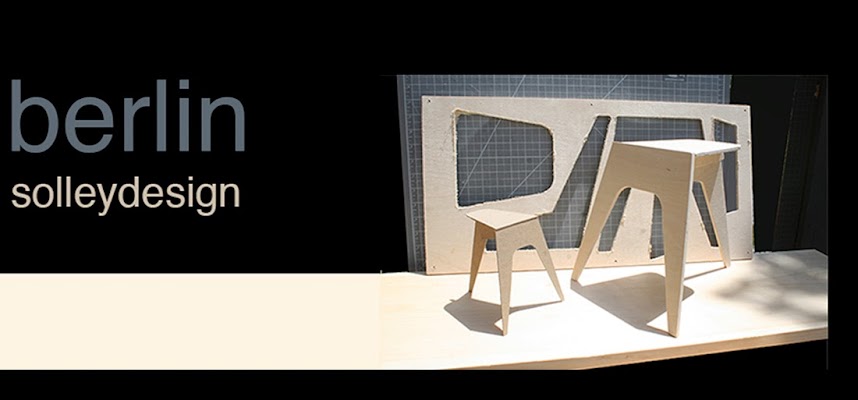Design on Demand.
Practical design from
the internet and accessible to everyone.
An interview for Impuls on SWR2 radio
June 29th 2015.
Katrin Boening and Sean Solley would like to remove barriers
to designer furniture and reveal that “chic” design can also be achieved with a
more considerate use of resources. They
want us to know that we don’t always need to use new materials or new machines
to create new products. In fact we could make better use of the materials we find
in our own homes; that could be the left overs from a freshly laid linoleum or
parquet floor, fabric surplus, shoe laces or anything else that comes to hand.
Respectively these resources represent the bi-products from commercial
manufacturing processes. Off cuts that, for a few Euro can be picked up at any
building supply store or hobby shop. Conventional methods of fabrication,
storage and distribution could be significantly reduced by these “Design on
Demand” principles.
AR
I can order your products
online or purchase them directly, but I could also select to build them myself,
right?”
KB
Exactly, you could receive a
digital file from us that will allow you to cut your own materials. You might
select your own colors or integrate a material that you have lying around at
home such as acrylic or textile offcuts. The main point is that you can
overtake the making process.
AR
That means that I can purchase
the instructions, or the component parts, from you and then find out which
carpenter could help me complete the product, which carpet store has a material
to meet my needs, but steel? As a consumer I wouldn’t know where to look first.
SS Of
course, but you would be surprised how many small workshops you have in your
locality. If you dig a bit deeper you’ll find good welders and material supply
companies doing business in your area; they are knowledgeable and ready to
help.
With their lamp designs it’s even
easier. A designer lamp with instructions that makes the process as easy as putting
Lego bricks together. But what if you’ve got two left hands or no time to build
your own?”
KB
Anyone who doesn’t want to
build their own can order a pre-finished one and then they just need to hang it
up!
For Katrin Boening and Sean Solley; Professor of Interior
Architecture and Design at Suffolk University in Boston, buying good,
functional design should not be a question of income.
AR Katrin,
I had the impression that you had a little shock when you visited the first design
shops in Germany. What struck you about the experience and what have you got to
contribute in contrast?
KB Yes,
we were really surprised just how expensive lighting is, and we said that
needn’t be the case anymore. People can, with minimal materials, arrive at
really good design solutions. That was really our starting point. We like to
use the stuff around us so we just got going. We picked out a material that
appealed to us and asked, OK, what can we do here? This material bends; lets
try this…..and we developed products that were unconventional as a result.
From design, the products are minimalistic but pleasantly
colorful. “Stylish” as we say in New German. It’s not just the form or the
materials that contribute to this; it’s the process itself that charts a new
direction. Katrin Boening and Sean Solley are asking the public to be conscious
of the hidden potential in everyday objects.”
KB
So the lamp; that won’t be
hung from the ceiling. No, that gets hung from the wall. The standing lamp
doesn’t stand on the floor; it leans on the wall. All sorts of other ideas
emerged, each with minimal material use and a tight budget, enabling us all to
afford one.
AR Good
design or many design classics are not necessarily environmentally friendly.
Often environmentally friendly products look a little inelegant or earthy but
not yours. What’s your take on this? How do good design, environmental
responsibility and sustainability come together?”
SS When
people work together efficiently we save a lot of time energy, a lot of time and
a lot of money. I think that’s achieved when people learn to appreciate how
design achieves these goals. We really want to promote awareness.
The manufacture of expensive products in low wage countries,
gigantic storage facilities, transportation of goods across many continents; each
can be significantly reduced through the wider adoption of “Design on Demand”.
At the same time, smaller, regional businesses can be supported; for example
the good old local tradesmen that appear to be under threat in Germany.”
AR What
are we looking at here is that a lamp?
KB This
is a lamp that can be leant against the wall. It’s made from timber dowels like
the ones you find in the DIY store, for low cost, and they’ve been sheathed
with a shoe lace; and so every lamp gets its own color. These are then held
together with uniquely shaped Plexiglas plates and….rubber bands”
AR …and
what’s it called?
SS That’s
the P-Y-L lamp.
AR ….and
I can build it or buy it off the internet; how much will it cost me?
KB This
lamp, or lampshade, costs about 80 Euros and the cloudlike lamp made with wire
costs in the region of 180 Euros.
Hear the original German audio
Hear the original German audio
